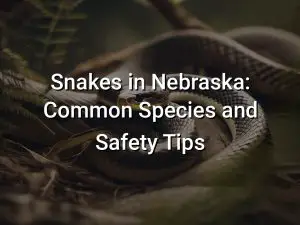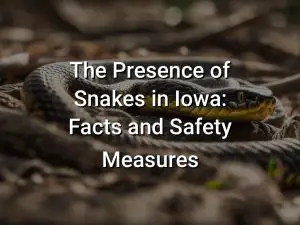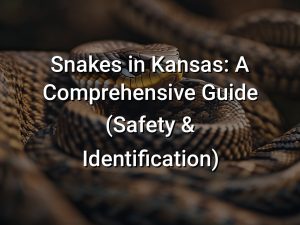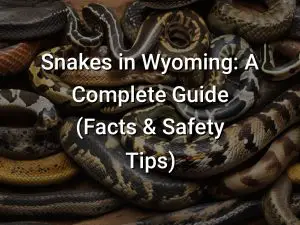Snakes in Massachusetts: Species, Distribution, and Safety Tips
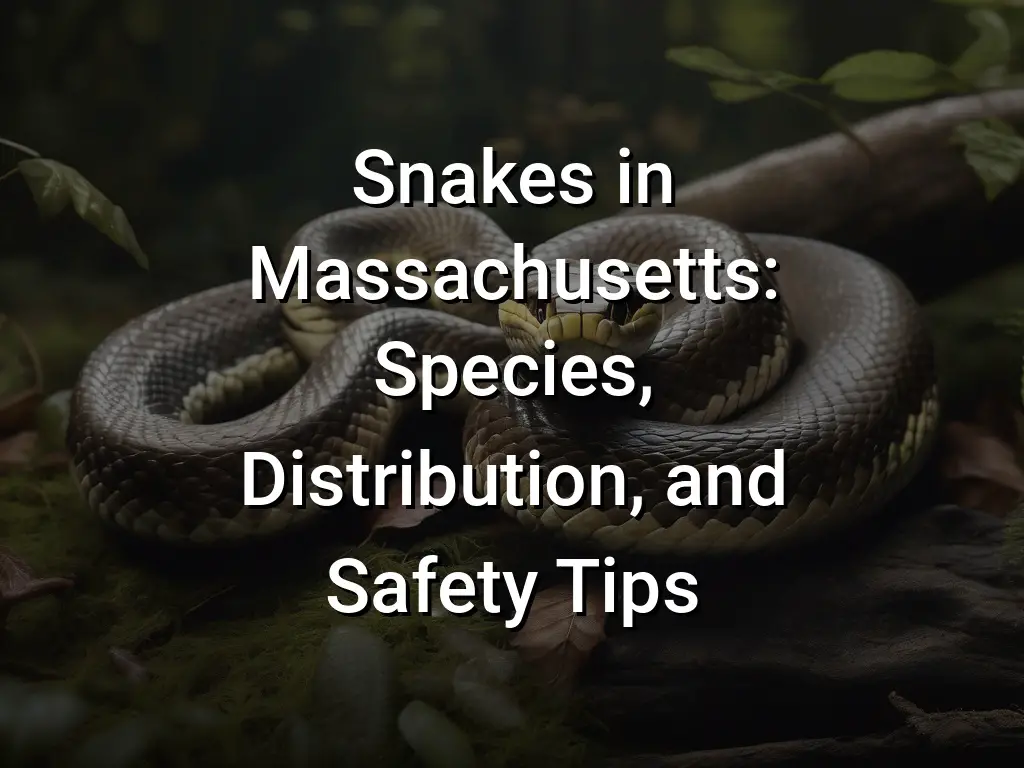
Snakes in Massachusetts? You might be surprised to learn that the state is home to a diverse array of snake species. From non-venomous snakes like the Garter Snake to the venomous Timber Rattlesnake, Massachusetts offers a fascinating glimpse into the world of these slithering creatures.
In this article, we’ll provide an in-depth look at the species, distribution, and safety tips when it comes to snakes in Massachusetts. Whether you’re a curious nature enthusiast or simply want to stay safe while exploring the great outdoors, we’ve got you covered.
Quick Links
Introduction and Background
Snakes are fascinating creatures that play an important role in our ecosystem. In Massachusetts, there are several species of snakes that are native to the state. While some people may fear snakes, it is important to understand and appreciate their presence.
Snakes in Massachusetts serve a valuable purpose by controlling populations of rodents and other small animals. They are also indicators of the health of our environment, as they can be sensitive to changes in habitat quality.
While most snakes in Massachusetts are harmless, it is still important to exercise caution and respect when encountering them. This article will provide information on common snake species in Massachusetts, their distribution and habitat, safety tips for dealing with snakes, how to identify snakes in the state, snake behavior and life cycle, protecting snakes and their habitats, snakebite first aid, and snake conservation efforts in Massachusetts.
Whether you are a nature enthusiast or simply want to be prepared, this article will provide you with the knowledge and resources to coexist safely with snakes in Massachusetts.
Common Snake Species in Massachusetts
Massachusetts is home to a variety of snake species, including both harmless and venomous snakes. Here are some of the common snake species you may encounter in the state:
- Eastern Garter Snake (Thamnophis sirtalis): This is one of the most common snakes in Massachusetts and is non-venomous. It has a long, slender body and is typically brown or gray with three yellow stripes running along its length.
- Northern Water Snake (Nerodia sipedon): The northern water snake is often found near bodies of water, such as ponds, lakes, and marshes. It is non-venomous and has a dark brown or black color with dark bands or blotches on its body.
- Ribbon Snake (Thamnophis sauritus): The ribbon snake is a small, thin snake with a distinctive yellow stripe running down the center of its body. It is often found near water and feeds on small fish and amphibians.
- Eastern Milksnake (Lampropeltis triangulum): The eastern milksnake is non-venomous and has a pattern of reddish-brown or black bands on a light gray or tan background. It is often mistaken for the venomous coral snake, but can be identified by its red and black bands touching yellow bands.
- Eastern Rat Snake (Pantherophis alleghaniensis): The eastern rat snake, also known as the black rat snake, is a large snake that can reach lengths of up to 6 feet. It is non-venomous and is typically black with some individuals having white or yellow markings.
These are just a few examples of the snake species you may encounter in Massachusetts. It’s important to remember that most snakes in the state are harmless and play a beneficial role in the ecosystem by controlling rodent populations. If you encounter a snake, it is best to observe it from a distance and allow it to move on its own.
Distribution and Habitat
Snakes in Massachusetts can be found in a variety of habitats throughout the state. They have adapted to live in different ecosystems, including forests, wetlands, meadows, and even urban areas.
One of the most common snake species in Massachusetts is the garter snake, which is found in a wide range of habitats. Garter snakes prefer moist environments and can often be found near bodies of water, such as ponds, streams, and marshes. They are also commonly found in grassy areas, gardens, and woodlands.
Another common snake species in Massachusetts is the black racer, which can be found in a variety of habitats, including forests, fields, and suburban areas. Black racers are known for their speed and agility, and they are often found basking in the sun on rocks or other warm surfaces.
Snakes in Massachusetts also inhabit rocky areas, such as cliffs and outcrops, where they can find shelter and bask in the sun. This habitat is particularly suitable for species like the timber rattlesnake, which prefers wooded areas with rocky terrain.
It is important to note that snakes are ectothermic, meaning they rely on external sources of heat to regulate their body temperature. This is why snakes can often be found sunbathing on rocks or other warm surfaces. They may also seek out sheltered areas, such as burrows or fallen logs, to escape extreme temperatures.
Overall, snakes in Massachusetts have adapted to a wide range of habitats and can be found throughout the state. It is important to be aware of the potential presence of snakes and to take precautions when encountering them.
Venomous Snakes in Massachusetts
While Massachusetts is home to a variety of snake species, only two are venomous: the eastern timber rattlesnake (Crotalus horridus) and the northern copperhead (Agkistrodon contortrix).
The eastern timber rattlesnake is a large, venomous snake that can grow up to 5 feet in length. It is typically brown or gray with dark-brown or black crossbands and a distinct rattle on its tail. This snake prefers rocky, forested areas, especially near ledges and rocky outcrops.
The northern copperhead is a relatively small snake, usually around 2 to 3 feet in length. It has a distinct copper-colored head and a pattern of dark-brown or reddish-brown hourglass-shaped markings on its body. The northern copperhead is found in a variety of habitats, including forests, fields, and wetlands.
It’s important to note that while these snakes are venomous, they are generally shy and non-aggressive. They will usually try to avoid human interaction if given the opportunity. It’s best to observe these snakes from a safe distance and refrain from approaching or disturbing them.
If you encounter a venomous snake in Massachusetts, it’s recommended to leave the area calmly and immediately. Do not try to handle or capture the snake. Keep in mind that snakes play an important role in the ecosystem and are protected by state laws, so it’s important to respect and appreciate their presence while taking appropriate precautions for safety.
Safety Tips for Dealing with Snakes
While encountering snakes in Massachusetts can be a startling experience, it’s important to remember that most snakes are harmless and play a vital role in maintaining the ecosystem. However, to ensure your safety and the well-being of the snakes, it’s essential to follow these safety tips when dealing with snakes:
- Learn to identify different snake species: Familiarize yourself with the common snake species in Massachusetts. Knowing the difference between venomous and non-venomous snakes can help you make informed decisions when encountering them.
- Keep a safe distance: When you encounter a snake, it’s important to maintain a safe distance. Avoid provoking or approaching snakes, as they may feel threatened and react defensively.
- Do not handle snakes: Unless you are a trained professional, it’s best to avoid handling snakes. Even non-venomous snakes can bite if they feel threatened. Instead, appreciate them from a distance.
- Keep your surroundings clean: Snakes are attracted to areas with abundant food sources, such as rodents. By keeping your surroundings clean and free of debris, you can reduce the likelihood of snakes taking up residence near your home.
- Secure your property: Seal any gaps or holes in your home’s foundation or walls to prevent snakes from entering. This can also help deter other pests from entering your property.
- Be cautious in snake habitats: When hiking or exploring wooded areas, watch where you step and use caution. Snakes can blend into their surroundings, so be aware of your surroundings and avoid stepping on or near snakes.
- Teach children about snake safety: Educate children about snake safety and the importance of respecting snakes in their natural habitats. Teach them to stay calm and back away slowly if they encounter a snake.
- Call a professional: If you have a snake infestation on your property or believe you have encountered a venomous snake, it’s best to contact a professional snake removal service for assistance. They have the expertise to handle the situation safely and effectively.
By following these safety tips, you can coexist with snakes in Massachusetts and ensure the safety of both yourself and the snakes. Remember, snakes play a valuable role in the ecosystem and should be respected and protected.
Identifying Snakes in Massachusetts
Massachusetts is home to a variety of snake species, each with its own unique characteristics and appearance. Being able to identify the different types of snakes in the state can help you better understand and appreciate these reptiles. Here are some common snakes you may encounter in Massachusetts:
- Garter Snake (Thamnophis spp.): Garter snakes are one of the most common snake species found in Massachusetts. They have long bodies with distinctive yellow or white stripes running along their back and sides. Garter snakes are harmless and play an important role in controlling rodent populations.
- Northern Watersnake (Nerodia sipedon): Northern watersnakes are non-venomous snakes that are often found near water bodies like lakes, ponds, and marshes. They have dark brown or black bodies with dark bands or blotches. These snakes are excellent swimmers and feed on fish, frogs, and other aquatic prey.
- Milk Snake (Lampropeltis triangulum): Milk snakes are small to medium-sized snakes that are known for their vibrant colors. They have a reddish-brown or dark-brown body with bold, bright-colored bands that can be yellow, orange, or reddish. Milk snakes are harmless and are often mistaken for venomous coral snakes.
- Eastern Ribbon Snake (Thamnophis sauritus): Eastern ribbon snakes are slender snakes with a long, narrow body and a distinctive yellow or white ribbon-like stripe running down their back. They are semi-aquatic and can often be found near wetland areas or along the edges of ponds and streams.
It’s important to note that while most snakes in Massachusetts are harmless and beneficial to the ecosystem, there are a few venomous species to be aware of. We’ll discuss these venomous snakes in the next section.
Snake Behavior and Life Cycle
Snakes, like all reptiles, have unique behaviors and life cycles that contribute to their survival and reproduction. Understanding snake behavior can help individuals coexist with these fascinating creatures and reduce the risk of encountering them in potentially dangerous situations.
Snakes are ectothermic, meaning they rely on external sources of heat to regulate their body temperature. This is why you may often see snakes basking in the sun to warm up or seeking shelter in cool areas to avoid overheating. Snakes may also hibernate during the colder months to conserve energy.
Most snakes are carnivorous and feed on a variety of prey such as rodents, birds, eggs, and even other snakes. They have specialized jaws and flexible bodies that allow them to swallow prey whole. Snakes are typically opportunistic predators and will strike and constrict their prey to immobilize and consume it.
Snake life cycles vary depending on the species. They typically reproduce sexually, with males and females engaging in courtship rituals and mating. Some species lay eggs, while others give birth to live young. Snake eggs are often deposited in protected areas such as under rocks or logs, where they are left to incubate until hatching.
After hatching, young snakes are fully independent and must fend for themselves. They may go through several shedding cycles, called ecdysis, as they grow. Shedding allows snakes to replace damaged skin and remove parasites. The frequency of shedding varies depending on the snake’s age and environmental conditions.
Snakes play important roles in ecosystems as both predator and prey. They are crucial for maintaining balanced populations of rodents and other small animals. Some snakes, such as the Eastern Hognose snake, even have unique defense mechanisms such as playing dead or puffing up their bodies to ward off potential predators.
It’s important to respect and appreciate snakes’ natural behaviors and roles in the environment. If you encounter a snake in the wild, it’s best to observe from a safe distance and avoid disturbing or provoking it. Remember, snakes prefer to avoid confrontations with humans and will typically retreat if given the opportunity.
Protecting Snakes and their Habitats
Protecting snakes and their habitats is crucial for maintaining biodiversity and ecosystem health. Snakes play important roles in ecosystems by controlling rodent populations and serving as prey for other animals. Here are some steps that can be taken to protect snakes and their habitats in Massachusetts:
- 1. Conservation efforts: Support local conservation organizations and initiatives that focus on snake protection and habitat preservation. These organizations work to educate the public, conduct research, and implement conservation plans to ensure the survival of snake species.
- 2. Preservation of natural habitats: Protecting natural habitats such as forests, wetlands, and grasslands is essential for snake conservation. These habitats provide food, shelter, and breeding grounds for snakes. Avoid destroying or fragmenting snake habitats through urbanization or land development.
- 3. Minimize pesticide use: Pesticides can be harmful to snakes and their prey. Reduce the use of pesticides in your garden or property to prevent accidental harm to snakes and other wildlife.
- 4. Avoid unnecessary snake killings: Many snakes are killed out of fear or misunderstanding. It is important to learn about different snake species and their behavior to avoid unnecessary killings. If you encounter a snake, give it space and observe it from a safe distance.
- 5. Snake-friendly landscaping: Create snake-friendly landscaping by incorporating features such as rock piles, fallen logs, and brushy areas. These features provide hiding places and basking spots for snakes. Avoid using chemical fertilizers and pesticides in your yard, as they can harm snakes and their prey.
- 6. Responsible pet ownership: Keep your pets under control and prevent them from harassing or killing snakes. Cats and dogs can pose a threat to snake populations.
- 7. Educate and raise awareness: Educate others about the importance of snakes in ecosystems and the need for their conservation. Raise awareness about snake species in Massachusetts and debunk common myths and misconceptions about snakes.
By taking these steps, we can contribute to the protection of snakes and their habitats, ensuring their survival for future generations to appreciate and enjoy.
Snakebite First Aid
If you or someone you know is bitten by a snake, it is important to seek medical attention immediately. In the meantime, there are several steps you can take to provide first aid and minimize the effects of the snakebite:
- Stay calm and try to keep the affected person calm as well. Panicking can increase heart rate and spread the venom more quickly.
- Remove any jewelry or tight clothing near the bite site, as swelling may occur.
- Keep the affected limb immobilized and positioned at or below heart level to reduce blood flow and the spread of venom.
- Clean the bite wound gently with soap and water.
- Apply a clean, dry bandage over the bite, leaving the fang marks visible.
- Do not apply a tourniquet or attempt to suck out the venom, as these methods can do more harm than good.
- Do not apply ice or use a cold compress directly on the bite, as it can worsen tissue damage.
- Do not use a “snake bite kit” or attempt to cut or suction the bite site.
- Note the appearance of the snake, if possible, to help medical professionals identify the species and administer appropriate antivenom.
Remember, snakebite first aid should not replace medical treatment. It is crucial to go to the nearest hospital or call emergency services for professional medical care as soon as possible.
Snake Conservation Efforts in Massachusetts
Snake conservation efforts play a crucial role in preserving the diverse snake species found in Massachusetts. The state has implemented various initiatives and programs to protect and conserve these reptiles and their habitats.
One of the key organizations involved in snake conservation in Massachusetts is the Massachusetts Division of Fisheries and Wildlife (MassWildlife). MassWildlife conducts research on snake populations, monitors their habitats, and implements management practices to ensure their long-term survival.
Another important conservation program in the state is the Massachusetts Natural Heritage and Endangered Species Program (NHESP). NHESP works to identify and protect the most at-risk snake species in Massachusetts through habitat management, public education, and conservation planning.
Land preservation is also vital for snake conservation. The state has designated several protected areas, such as state parks, wildlife management areas, and nature reserves, which serve as important snake habitats. These protected areas provide undisturbed habitats for snakes to thrive and reproduce.
In addition to government organizations, several non-profit organizations and local conservation groups are actively involved in snake conservation efforts. These organizations work to raise awareness about the importance of snakes in the ecosystem and promote conservation practices among the public.
Public participation is crucial for successful snake conservation. Residents of Massachusetts can contribute by supporting local conservation organizations, participating in citizen science initiatives, and practicing responsible land use to protect snake habitats.
Overall, the collaborative efforts of government agencies, non-profit organizations, and the public are essential for the conservation of snakes in Massachusetts. Through these combined efforts, it is possible to ensure the survival and well-being of these fascinating reptiles in the state.
Conclusion
Snakes are a fascinating and diverse group of animals that play an important role in ecosystems. While some people may have a fear or discomfort around snakes, it’s important to remember that most snakes in Massachusetts are harmless and beneficial. By understanding their behavior and taking proper safety precautions, we can coexist with these creatures and appreciate the role they play in our environment.
If you encounter a snake in Massachusetts, remember to stay calm and give it space. It’s important not to handle or provoke snakes, as this can increase the risk of bites. If you are unsure about the species or need assistance, contacting a local wildlife agency or snake expert can provide guidance and support. By working together, we can protect both snakes and their habitats, ensuring a healthy and balanced ecosystem for future generations.



